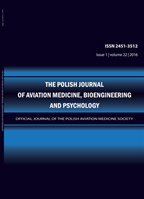2015, Volume 21, Issue 1
Intellectual Processes and Psychomotor Performance of Professional Drivers in Conventional Psychological Tests and Test2Drive
Karolina CZAPSKA1
-------------------------------------------------------------------------------------------------
1Inter-area Individual Humanistic and Social Studies, University of Warsaw
Autor korenspondencyjny: Karolina CZAPSKA; Inter-area Individual Humanistic and Social Studies, University of Warsaw; email: k.czapska12[at]gmail.com
Full text
Streszczenie
Introduction:
Drivers’ examinations constitute a very important area of traffic and transport psychology. Along with technological advances, the testing procedures changed over the years. The most recent response to these changes is the development of Test2Drive – an innovative battery of tests that is fully compliant with the effective methodologies. The objective of this article is to confirm whether the results of conventional tests are correlated with corresponding Test2Drive test results. The study was aimed at determination of potential correlations between conventional tests and Test2Drive components in corresponding areas of intellectual capacity and psychomotor fitness.
Methods:
Tests were conducted using the conventional instrumentation currently in use in psychology labs, including swirl meters, cross-type machines, simple reaction time tests, and Poppeleuter’s test as well as using the alternative Test2Drive system developed as a response to the methodology changes introduced in 2014. The study was conducted in 30 professional drivers, aged 23-62, who underwent tests at the LINIA drivers’ training center.
Results:
The analysis of results revealed a correlation between both types of tests with regard to oculomotor coordination as tested on a cross-type machine and using the SPANT test as well as visual attention as tested using Poppelreuter’s test and the PUT test. Correlations were also observed between variables such as age, number of collisions and number of fines and the results of the Test2Drive battery of tests. Studies revealed no correlations between tests with regard to anticipation as tested using a swirl meter and the PAMT test as well as reaction speed as measured by the simple reaction time test and the SIRT test.
Discussion:
The obtained results confirm that psychological examinations are a good basis for prediction of traffic behaviors of drivers. In addition, correlations between individual tests demonstrate that Test2Drive is a tool that may successfully replace instrumentation that has been used in drivers’ examinations to date.
Słowa kluczowe
anticipation, attention, drivers’ examinations, psychomotor fitness, Test2Drive
